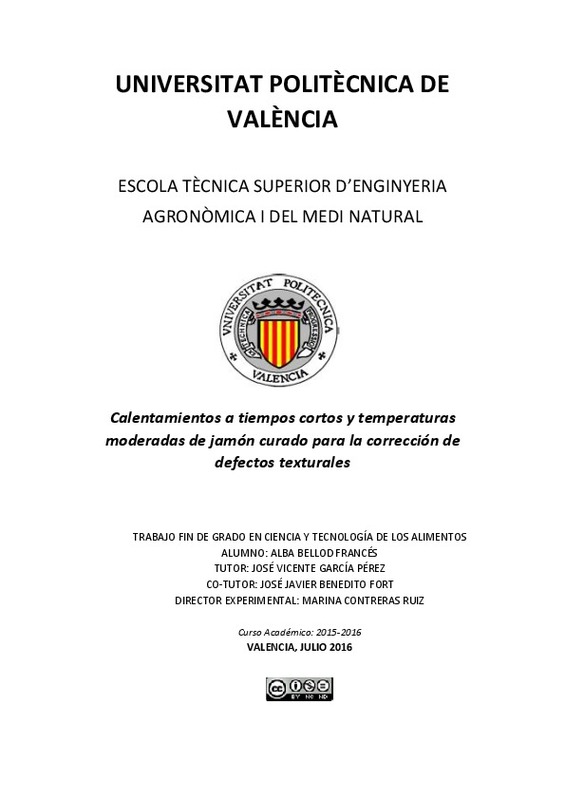|
Resumen:
|
[ES] Actualmente, existe una tendencia en la industria en reducir el contenido en sodio de los productos cárnicos crudocurados
por la problemática que conlleva un alto contenido de este mineral en la salud. La disminución ...[+]
[ES] Actualmente, existe una tendencia en la industria en reducir el contenido en sodio de los productos cárnicos crudocurados
por la problemática que conlleva un alto contenido de este mineral en la salud. La disminución de sal durante
el procesado del jamón curado puede originar una serie de problemas texturales, tales como la pastosidad, las texturas
blandas o la adhesividad, como consecuencia de una excesiva acción proteolítica. Estos defectos disminuyen la calidad
del producto provocando el rechazo del consumidor. Por lo tanto, el principal objetivo de este trabajo fue evaluar los
cambios de textura que conlleva un calentamiento a temperaturas moderadas y diferentes tiempos de jamón curado.
Los tratamientos térmicos se realizaron en cilindros de 2 cm de espesor y 2” de diámetro tomados de los tres principales
músculos del jamón (Bíceps femoris, Semitendinosus y Semimembranosus). En las muestras control, se realizaron
medidas de ultrasonidos de señal y se hizo un análisis de textura instrumental mediante un ensayo de compresión
simple; posteriormente se determinó el contenido de humedad. Por otro lado, las muestras a tratar se calentaron en
agua (50ºC) con y sin la aplicación de ultrasonidos de potencia durante 1, 3 y 5 horas, y se monitorizó el cambio de la
temperatura en el centro geométrico del cilindró. Para evaluar los cambios de textura también se realizaron medidas
de ultrasonidos de señal antes y después del calentamiento (24horas). En las muestras tratadas se realizó el análisis de
textura instrumental mediante compresión simple y se determinó el contenido en grasa.
Los resultados experimentales mostraron que, a mayor contenido en humedad, las muestras presentaron una menor
dureza, la cual se relacionó de manera significativa (p<0.05) con la velocidad ultrasónica. El calentamiento provocó una
mejora de los parámetros texturales, principalmente dureza y rigidez. En relación al tiempo de calentamiento (1, 3 y 5
horas), se observó un incremento progresivo en la dureza con el tiempo, pero su influencia no fue significativa (p>0.05).
Los ultrasonidos de potencia mejoraron la cinética de calentamiento (reducción del tiempo de calentamiento de hasta
14,3%) y no influyeron en los cambios texturales. Los cambios de velocidad ultrasónica en el jamón curado tras el
calentamiento se relacionaron de manera significativa (p<0.05) con los cambios texturales, por lo tanto, se puede
afirmar que la técnica de ultrasonidos de señal se considera como una tecnología adecuada para evaluar y cuantificar
las mejoras texturales que provoca el tratamiento térmico moderado.
[-]
[EN] In the meat industry, there is currently a trend to reduce the sodium content of the dry-cured products due to the
health issues related to its consumption. The reduction of salt in dry-cured ham processing could ...[+]
[EN] In the meat industry, there is currently a trend to reduce the sodium content of the dry-cured products due to the
health issues related to its consumption. The reduction of salt in dry-cured ham processing could cause some textural
problems, such as pastiness, soft textures or adhesiveness, as a consequence of very intense proteolytic action.
These defects reduce the quality of the product because of the consumer rejection. Thus, the main objective of this
project was to assess the textural changes linked to a heat treatment at mild temperatures and different times in
dry-cured ham.
Thermal treatments were carried out in cylindrical samples (2 cm in heaight, 2” in diameter), which were taken from
the three main muscles of the ham (Biceps femoris, Semitendinosus y Semimembranosus). In the control samples,
firstly, low-intensity ultrasonic measurements were carried out, secondly instrumental texture was measured by the
simple compression method and finally, the moisture content was also determined. The samples to be treated were
heated in water (50ºC) with or without the application of power ultrasound during 1, 3 and 5 hours, and the
temperature change was monitored in the geometric centre of the cylinder. In order to assess the changes in texture,
low intensity ultrasonic measurements were also performed before and after the heating (24 hours). Finally, in the
treated samples, the analysis of the instrumental texture was carried out through simple compression method and
the fat content was determined.
The experimental results showed that the higher the moisture content, the softer the samples, which was
significantly (p<0.05) related to the ultrasonic velocity. The heating caused an improvement of the texture
parameters, especially of hardness and stiffness. As for the heating time (1, 3 and 5 hours), a progressive increase in
the hardness was observed as the treatment time was longer, but its influence was not significant (p>0.05). Power
ultrasound sped-up the heating kinetics (heating times shortening of up to 14,3%) and did not have an impact on the
textural changes. The ultrasonic velocity changes in the dry-cured ham after the heating were significantly (p<0.05)
related to the textural ones, so it could be stated that low-intensity ultrasound is considered to be an appropriate
technology to assess and quantify the textural enhancement caused by a mild thermal treatment.
[-]
|







